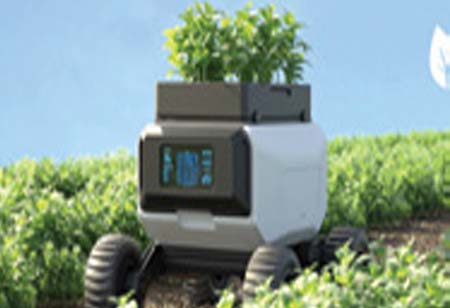Thank you for Subscribing to Agri Business Review Weekly Brief
The Impact of AI In-Row Weeding on Europe's Agriculture

By
Agri Business Review | Tuesday, November 11, 2025
Stay ahead of the industry with exclusive feature stories on the top companies, expert insights and the latest news delivered straight to your inbox. Subscribe today.
The European agriculture industry is undergoing a quiet transformation, driven by the emergence of Artificial Intelligence (AI)-powered solutions. Among these innovations, AI In-Row Weeding Solutions have gained significant momentum, enabling farmers to enhance crop yields, reduce operational costs, and promote environmentally sustainable practices. This advanced technology offers remarkable potential by ensuring precision and efficiency in weed management across diverse crops while supporting the European Union’s ambitious sustainability objectives. The adoption of AI In-Row Weeding marks a new era of agricultural automation, optimising resource utilisation for a more sustainable future.
Key Drivers of AI In-Row Weeding Adoption in Europe
One primary reason is stringent environmental regulations. European countries enforce strict agricultural and environmental policies to reduce pesticide and herbicide use. AI-powered In-Row Weeding solutions help farmers comply with these regulations by significantly minimising or eliminating the need for chemical weed control.
Additionally, sustainability goals play a crucial role in this adoption. The European Union’s Green Deal prioritises reducing carbon footprints and promoting sustainable farming practices. AI-based weeding aligns with these objectives by encouraging chemical-free, resource-efficient agriculture, contributing to long-term environmental protection.
Another significant factor is labor shortages in the agricultural sector. The declining availability of farm labor has intensified the demand for automation. AI-driven In-Row Weeding systems help address these workforce gaps by offering efficient, reliable alternatives that maintain productivity.
Moreover, rising consumer demand for sustainable produce has influenced this shift. European consumers increasingly prefer organic and sustainably grown food, leading farmers to adopt herbicide-free solutions. AI-powered weeding supports these expectations by enabling cleaner, more eco-friendly farming practices.
Technological advancements have made AI weeding solutions more accessible and practical. Improvements in AI capabilities, computing power, and sensor technology have accelerated the deployment of In-Row Weeding machines, allowing European farmers to embrace these innovations more readily.
Benefits of AI In-Row Weeding in Agriculture
AI-driven In-Row Weeding offers multiple benefits, starting with precision farming. These technologies selectively target weeds without harming crops, reducing chemical dependency while preserving soil biodiversity. This approach fosters healthier growing conditions, promoting sustainable agriculture.
Another significant advantage is cost reduction. By automating weed control, farmers lower labor expenses and decrease herbicide use. This reduces immediate operational costs and minimises long-term soil degradation, ensuring sustained agricultural productivity.
Furthermore, AI weeding contributes to improved crop yields. Weeds compete with crops for vital resources such as sunlight, water, and nutrients. By eliminating this competition, AI weeding systems optimise resource allocation, leading to healthier crops and higher yields. Given Europe’s climate-dependent farming cycles, timely and efficient weeding significantly enhances overall productivity.
The technology also supports enhanced soil and environmental health. Reducing chemical applications prevents pollution runoff into waterways, protecting natural ecosystems. Additionally, maintaining soil biodiversity strengthens crop resilience, contributing to long-term soil fertility.
AI-powered weeding machines offer real-time adaptability. These systems are equipped with advanced sensors and algorithms and continuously adjust to changing environmental conditions. Whether adapting to different soil types, weather variations, or crop growth stages, AI-driven weeding ensures optimal performance across diverse farming landscapes.
Technological Developments Shaping the Industry
Advanced vision systems and sensor integration allow these machines to distinguish between crops and weeds accurately. By utilising high-resolution optical sensors and imaging technologies, AI-powered weeding systems improve accuracy while becoming increasingly accessible due to declining sensor production costs.
Robotics and automation further enhance operational efficiency by reducing the reliance on manual labor. The continuous development of smaller, more versatile robots enables better navigation through narrow crop rows, improving weeding accuracy and efficiency.
The integration of mobile connectivity and cloud processing adds another layer of innovation. Farmers can remotely monitor equipment performance, receive alerts, and make necessary real-time adjustments, ensuring optimal utilisation of AI-driven systems.
Additionally, edge computing and artificial intelligence are critical in enhancing AI weeding solutions. Edge computing enables faster decision-making and improved performance by processing data locally within the machine instead of relying on centralised systems. This mainly benefits farmers in remote agricultural areas with limited internet connectivity.
The landscape of AI-driven In-Row Weeding is poised for significant transformation, with Europe anticipated to experience rapid adoption. Market players prioritise research and innovation to enhance affordability and accessibility, driving widespread implementation. Advancements in robotics, connectivity, and AI algorithms continue to refine efficiency and precision, further strengthening the impact of technology. Additionally, the growing emphasis on eco-friendly farming will accelerate demand as governments introduce incentives and grants to support sustainable agricultural practices.
As precision agriculture evolves, AI-powered In-Row Weeding systems will seamlessly integrate with broader precision farming solutions, fostering a highly interconnected ecosystem. These innovations, from automated planting to harvesting, will contribute to comprehensive agricultural optimisation. Future AI systems will also be tailored to address the specific needs of different European agricultural landscapes, including vineyards, highland farms, and northern crop fields, ensuring that no aspect of farming remains untouched by technological progress.
Moreover, these advancements will enhance food security by boosting productivity and crop yields. By supporting sustainable farming practices and meeting the demands of a growing population, AI-driven In-Row Weeding solutions will contribute to a more resilient and efficient agricultural sector across Europe.
AI In-Row Weeding solutions represent a transformative advancement in European agriculture. By integrating state-of-the-art technology with the imperative for sustainable farming, these innovations are driving a more efficient and environmentally responsible agricultural landscape. While challenges remain in scaling their implementation, ongoing research and technological progress underscore AI’s critical role in shaping the future of farming in Europe. As the continent advances toward greater sustainability, precision-driven technologies offer the potential to enhance agricultural practices while addressing global environmental challenges.





